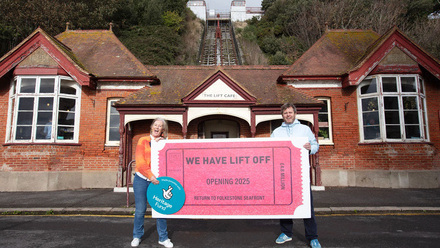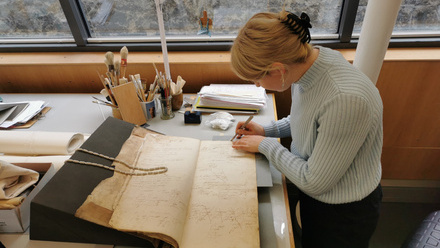My time as a stained glass conservation Icon Intern at Barley Studio
My six-month Icon internship was part of a three-year conservation project by Barley Studio of the collection of medieval glass at All Saints North Street Church in York, part-funded by The National Lottery Heritage Fund.
Barley Studio is a well known stained glass studio based in York. It has three focus points: conservation, creation of new windows and innovation.
Everyone at the studio can do almost everything, but each team member has their own speciality. The team consists of Keith Barley: managing director, Helen Whittaker: creative director, Alison Gilchrist: accredited conservator and my supervisor during this internship, Daniel Thomas: master glazier, Pierre Queval: technician, Adele Merlin: artist technician, and Cassandra Weston: operations administrator.
All Saints North Street houses one of the finest collections of medieval glass in the country. It was an absolute honour to come close to and work on three of these beautiful windows.
Originally trained as a glass and ceramics objects conservator, I also have always been interested in stained glass. So when Icon advertised for a six-month stained glass internship at Barley Studio and also encouraged conservators from other fields to apply (for a mutual learning opportunity), I simply had to apply and am very grateful that I was selected. The internship was an excellent opportunity to observe the differences and similarities between glass and ceramics conservation in my private practice and stained glass conservation at Barley Studio.
Below follows a selection of the things I learned during my internship.
The scale
Obviously, the scale is very different! I usually work on objects that are not enormous, and there is often just one piece, or sometimes two of the same thing. Stained glass windows can be huge and can consist of many panels. It means a whole different approach, and every action is repeated multiple times. Also, the architectural setting is very different to smallish objects that can be placed on a shelf.
Cleaning
At Barley Studio, stained glass panels are cleaned with deionised water and cotton wool. I am familiar with a similar technique in glass and ceramics conservation, but I use small cotton wool swabs on sticks. At Barley Studio, they often use cotton wool balls because, as mentioned above, the scale is so different.
After they arrive in the studio (and when the glass and paint are checked to be stable), the panels are carefully brushed with a soft brush and hoovered to remove loose surface dirt. Then cotton wool balls with deionised water are delicately rolled over the surface of the glass, constantly checking if no paint is removed. The dirt on the inside of church windows usually consists mostly of deposited candle smoke.
I cleaned many panels, for example the whole East Window of All Saints North Street, both front and back side, which took several days. It is a great opportunity to see all the details of the window.

Bonding
Before current adhesives were available, glaziers would repair broken pieces of stained glass with mending leads. They either used H-shaped lead or strap leads.
With H-shaped lead, the glass is slotted into each part of the H-shape and it has a heart separating the glass pieces. Strap leads are strips without a heart and are added in situ only over the glass surface. When there were many breaks, the window would become quite illegible because all that lead would make it more difficult to see the glass.
Sometimes the glaziers grozed (nibbled) the break edges with a tool to make the pieces of glass fit, but sometimes they did not have to do that, and the break edges remained untouched. This last option makes it possible to remove the mending lead and glue the broken pieces back together again.
Alison Gilchrist, my supervisor, was very good at spotting mending leads, and if possible, they were removed, and we bonded the glass. Some breaks did not have mending leads. When needed, we also bonded these pieces, mostly by taking them out and sometimes in situ.
Barley Studio prefers to bond with clear silicone adhesive (they also use epoxy resins). The advantage of silicone adhesive is that it is reversible and stays relatively flexible, which helps protect the glass from breaking when under stress.
Barley Studio developed the following technique: the shards are held with small clips, and the glass stands vertically while curing (making hem look like little animals). Silicone adhesive is a new material for me; I generally use epoxy resins and Paraloid B72 for bonding. (Paraloid B72 is not so suitable for the architectural environment of stained glass).
Also, the bonding technique is new for me. I use adhesive tape to support the shards while curing, or position the shards in such a way that gravity keeps them in place. I also sometimes use clamps, but not in this way. It always interests me to learn new methods.

Fills and retouching
In my studio, I make the fills from a different material than the object, usually from epoxy resins, plaster of Paris or conservation grade acrylic filling material. Then I retouch the fills with epoxy resins or acrylic glaze mixed with dry artist pigments or Golden acrylics. I never fire objects or fills, but do sometimes use a low-temperature incubator.
At Barley Studio, missing areas are usually filled with glass (they also do epoxy fills for small areas). The glass is matched to the original as close as possible and if necessary, painted and kilnfired.
It is good ethical practice to clarify which pieces have been newly painted, so they can not be confused with the original glass. Therefore each newly painted piece is marked with the logo of Barley Studio and the year, using a diamond pen. Retouching also takes place and is reversible and not fired. It is called cold painting.
Retouching is used to disguise the damage of historic painted glass. Several types of paint can be used, and it depends on the situation which is most suitable. I did some cold painting on panels of the west window of Rotherham Minster using grisaille (glass paint used for kiln-fired glass) mixed with gold size.
I also learned to cut glass, paint and lead. I made a small exercise piece based on an existing piece. In addition, I was kindly given the opportunity to make a larger piece based one one of the panels of a window of All Saints North Street.

On-site
In my own practice, I usually work in my studio. It is the same in Barley Studio: most conservation work is done in the studio. However, there is also an important part of the work that has to be done on-site: the windows have to be taken out and after conservation treatment put back in.
After conservation, the stained glass windows at All Saints North Street are shielded from the elements by protective glazing, placed in the window’s original groove. The window is framed in bronze frames and placed slightly in front of the protective glazing, leaving a small gap between the two windows and a small opening at the bottom for ventilation of the interspace.
I went a few times on site to All Saints North Street to observe how the Barley Studio team removed windows, placed protective glazing and reinstated conserved windows. It gave me a good impression of the process. It was fascinating to see how they worked with such precision and delicacy. I helped with holding ladders, picking up dropped tools, carrying panels and also was allowed to do a little mortar chipping and snipping of copper wires.
The bronze frames have lead tape attached around the outside, which is folded towards the inside of the panels because it is easier to fit them that way. Once the panels are in place and attached to the stone, the lead has to be folded back and smoothed over the stone. I was allowed to do that for the Pricke of Conscience window and went up on the scaffolding. An added bonus was that from the top of the scaffolding, I could have a close-up look at the wooden carved angels that decorate the ceiling of All Saints North Street church.

Documentation
In my own studio, I write quotations, treatment reports and take photos before, during and after treatment. Barley Studio also does that. Additionally, there were other forms of documentation. I was involved in two types: rubbings and digital documentation
Rubbings of each panel are the traditional way of documenting stained glass. These rubbings are made for two purposes: for documentation and, in case of re-leading: as a template. The rubbings are made by placing a thin sheet of paper over the panel and rubbing over the lead with heel ball (a type of wax crayon). At Barley Studio, breakages and other significant features before treatment are annotated on the rubbings. After treatment, the conservation work is also annotated on the rubbings. I have made many rubbings, and I feel I have contributed to the history of these panels because they will possibly be used by glaziers and researchers in the future.
Digital documentation at Barley Studio is slowly taking over from rubbings, although rubbings for re-leading will always be needed, and it also depends on the requirements of the client. Digital documentation involved editing the before and after treatment photos (made by Alison) in Photoshop and then importing and annotating them with symbols for damage and treatment in Illustrator. I did most of this kind of digital documentation for the three windows of All Saints North Street that were treated during my internship. I certainly see a use for this style of annotated photographs in my private practice.

Teamwork
Another difference is colleagues. I usually work on my own, and at Barley Studio, I worked with a team, which I enjoyed very much. Not only because they are all very talented and skilled and were generous with sharing their knowledge, but also to have discussions about conservation treatments. During each project, windows are laid out, and conservation options are discussed with Keith Barley, Helen Whittaker and Alison. It was a great learning opportunity to hear the different views and see how a consensus is reached.
I also very much enjoyed comparing notes with Alison between our respective fields of conservation. I am taking away techniques that I can also apply to ceramics and glass objects conservation, and I was able to share some of the techniques that I am familiar with, mainly regarding epoxy resins.
Conclusion
Although stained glass and glass objects are made from the same material, there are similarities and differences in treatments.
I think it is beneficial for conservators to experience other disciplines because they can learn from each other and make the profession stronger.
It has been an amazing six months at Barley Studio. I have a much better understanding of the conservation process of stained glass and learned many skills. I hope that I can do more stained glass conservation in the future.
I am very grateful to the team of Barley Studio for giving me this wonderful opportunity and for being so generous with sharing their knowledge and their teaching, to Icon for organising the internship and to the National Lottery Fund for funding it.






